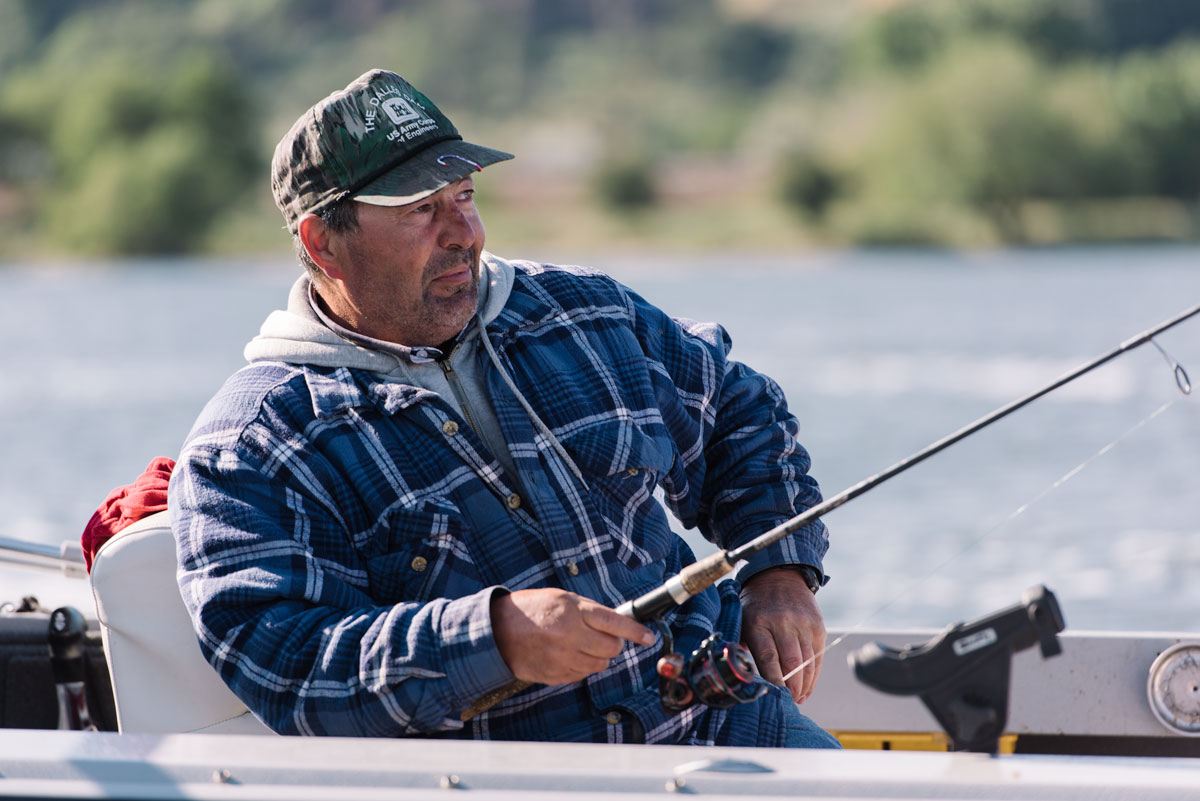EARLY SEASON OPENER 2025: The Dalles station will open April 14, 2025 and Columbia Point/Umatilla stations will open April 21, 2025. All station hours are now posted.
EARLY SEASON OPENER 2025: The Dalles station will open April 14, 2025 and Columbia Point/Umatilla stations will open April 21, 2025. All station hours are now posted.

An angler with a fishing pole on a boat in the river, 2016. Photo by Isaac Lane Koval.
You will need assorted soft plastic lure bodies. Use grubs or worms (3 to 6 inches long), tube jugs (3 to 4 inches long), or shad type bodies (1 1/2 to 4 inches long). The color search section of this document explains which colors to use. One-eighth or one-quarter ounce jig-heads are the most commonly used. Jig-heads of one-half ounce or more are occasionally used from a boat, you may also want jig-heads as heavy as 1 1/2 ounces or bottom walkers (wire “arms” weighted with leads).
The basic technique for fishing grubs is to drift-fish. Cast slightly upstream, straight out, or slightly downstream, depending on the amount of current. Count down to the proper depth (one-one thousand, two-one thousand…), then start reeling.
You are at the proper depth if your lure occasionally lightly ticks on the rocks. Use the lightest jig-head that allows you to reach the bottom consistently. In slower currents, larger grubs (5 to 6 inches long) may work better.
A “dead” drift, with no action imparted, is generally the most effective and the least tiring to retrieve. However, movement may trigger strikes and varying reel speed, adding twitches, jigs, flutters, sweeps, or pauses is sometimes more effective.
When casting toward shore, slow your retrieve as your lure moves into deeper water to allow if to follow the bottom contour. You may need heavier jig-heads when fishing offshore structures in deeper water.
In addition to the standard drift-fishing technique, there are a couple of specialized methods that work well from a boat. With weight heavy enough to keep the grub near the bottom and the line straight down from the boat, drift your boat along with the current. The jig-head should occasionally tick the bottom. Drifting or trolling very slowly with a bottom-walker is another good technique. When using bottom-walkers, rig your grub directly on a 1/0 to 3/0 hook and use a leader 18 to 36 inches long tied to the top eye.
Pay close attention to the light taps that tell you a Northern Pikeminnow is sampling your grub. Quickly set the hook when you feel a tap. It’s more important that the hook set be fast and hard. A quick, tight snap is all it takes.
Northern Pikeminnow will sometimes ignore one color grub and very actively hit another. A good basic rule is, for bright light and clear water, use light colors; for low light and cloudy water, use dark colors. Northern Pikeminnow have been caught on over 100 colors, but color preferences vary from day to day and hour to hour. If you like a particular color, try it, but if that one doesn’t work, be ready to try another. Fish each color for about 15 minutes and then try a different color if you don’t have good results.
At night, Northern Pikeminnow are most consistently attracted to grubs with purple bodies and either blue or green glitter. These colors are also available with chartreuse tails, which often work well. Try purple grubs with blue or green glitter first.
Next, try a color with just black glitter (salt and pepper). grubs with an orange-brown body and a chartreuse tail, or a “smoke” body with a chartreuse tail work well. Red is the last basic glitter color to try for night fishing. Grubs with a purple and black body with a chartreuse tail and red glitter or a motor-oil green color with red glitter should work if the fish are keyed toward red.
For daytime fishing, try light-colored bodies like chartreuse or smoke. Experiment with glitter colors. Fish don’t always follow rules; light colors or white sometimes work at night and dark colors sometimes work during the day. Experiment with colors to find what works best for you.
Washington Department of Fish and Wildlife
800-858-9015 Toll Free
360-906-6707
pikeminnow@dfw.wa.gov
800-769-9362 Toll Free
503-595-3297
vouchers@pikeminnow.org
503-230-3862
800-622-4520 Visitor Center